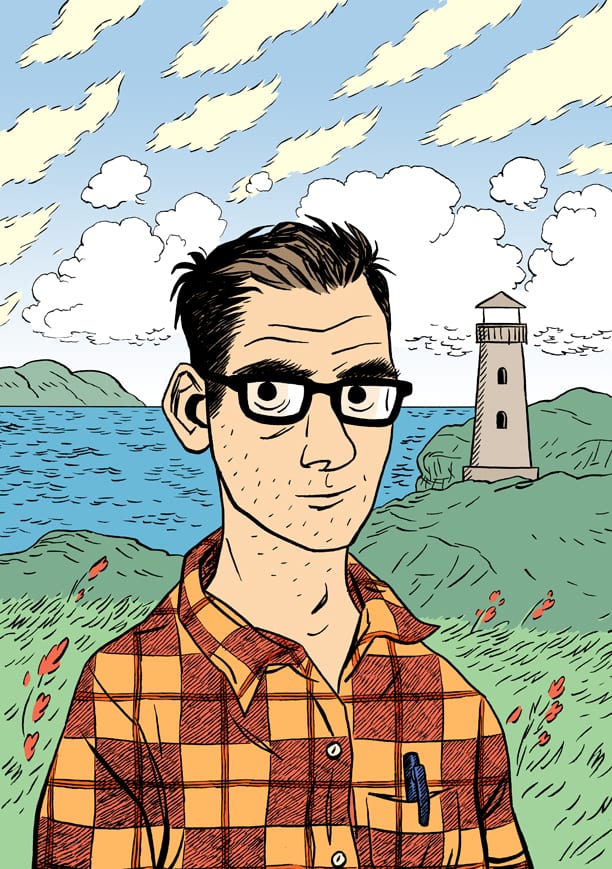Today, Greg Hunter's great Comic Book Decalogue podcast returns with a special double-sized holiday special.
Dylan Horrocks discusses the magic of Tove Jansson, the problems of late-period Eisner, and the troubled legacy of Dave Sim. All that, and a special guest drops by!
We also bring you Rob Kirby's review of Jane Mai's See You Next Tuesday:
In the introduction to a recent interview she conducted with Mai on TCJ, Annie Mok describes Tuesday as a "raucous collection of comics and scraps." “Scraps” is an apt description: many of these pages come across as little spur-of-the-moment exercises (in the interview Mai reveals she drew them on loose pieces of paper and not in a sketchbook). In her text Mai often eschews punctuation, which lends a distanced, stream-of-consciousness effect. Her line switches from scrawly and thin to a more directly appealing (and legible) bold line, while her persona alternates between bratty and vulnerable, and bewildered and snarky–all of which match her childlike drawings perfectly.
And also Daniel Kalder's review of Philippe Druillet's 6 Voyages of Lone Sloane:
As a youthful reader of 2000AD in its early '80s heyday I grew up with compressed narratives, but this is something else: Druillet achieves almost Book of Genesis levels of symbolic density. Lone Sloane is a tripped-out attempt at creating cosmic myths, psychedelic visions, an assault on the fabric of reality on paper. The pages seethe with depictions of impossible machines, fantastic architecture, cosmic destruction, and ultra-absurd deus ex machina plot interventions. There is so much going on that the ideas and imagery cannot be contained in a traditional panel grid, so Druillet continues throughout to assault the reader/viewer with splash pages, jagged panels, pages without borders. It is the use of layouts in service of disorientation, breaking down the order of page to scramble the senses. And yet at the same time, Druillet "sees" these images with incredible clarity; the precision and meticulous detail of his imagery gives it an intense solidity.
Meanwhile, elsewhere:
—Reviews & Commentary. It's not really comics, but it's Jeet Heer and it's close enough I can't resist linking to it: The New Republic on the year in superheroes.
With its emphasis on violence as a solution, the superhero genre often lends itself to simplistic solutions to complex problems. It is hardly an accident that in a New York Times Magazine interview, Ted Cruz named Rorschach as one of his favorite comic-book characters, the insane and uncompromising right-wing anti-hero from the graphic novel Watchmen. Campaigning in Iowa this summer, Donald Trump took a bunch of kids up for a helicopter ride. “Are you Batman?” a nine year old boy asked the real estate mogul. “I am Batman,” Trump replied. Trump is certainly as wealthy as Batman (a.k.a. billionaire Bruce Wayne), who in his latest incarnation in The Dark Knight Rises (2012) acted as a reactionary hero defending the wealthy of Gotham City from the envious rabble. Cultural critics like Marshall McLuhan and Walter Ong long ago argued that the superhero genre was injecting fascist ideas into popular culture, a critique that cannot be easily dismissed. As Ong argued in a 1945 article for the Arizona Quarterly, “The notion of a ‘superman’ is part of the herdist economy of the Nazi Third Reich….The Superman of the cartoons is true to his sources. He is not another Horatio Alger hero or a Nick Carter; he is a super state type of hero, which definite interest in the ideologies of herdist politics.”
At The New Yorker, Matt Alt writes about Shigeru Mizuki.
Today, Mizuki’s name is virtually synonymous with “Kitaro” and the yokai. Given the smashing success of this long-running kids’ franchise, which has appeared in fits and starts for more than half a century, it’s tempting to dub Mizuki the Disney of Japanese monsters. But Mizuki’s disinclination to whitewash the darker side of the human condition out of even his children’s fare makes him more like a Japanese Vonnegut. His comics brim with subtle and not-so-subtle references to the wars of his own and other nations, untrustworthy authority figures, and the consistent failure of violent solutions to problems.
For The Guardian, Ian Williams picks his ten favorite "uncanny" graphic novels.
And finally, for Comics Forum, Maria Evdokimova interviews scholar Misha Zaslavskiy about the history of Russian comics:
In the USSR, Western comics, mostly American ones, were generally criticized, but the works of such distinguished authors as Jose Cabrero Arnal, Jean Effel, Herluf Bidstrup, and Ollie Harrington were willingly popularized, since they were communists. In the Great Soviet Encyclopedia the magazine Vesyolye Kartinki was cited as an example of comics.
But of course, official rejection did take place. One of the founders of Yugoslavian comics, Yuri Lobachyov, made an attempt to serially publish a story called “The Hurricane Comes To The Rescue” in the children’s magazine Kostyor (The Campfire), but had to shut down the publication mid-course.
[...]
Though ideologically, by Soviet standards, there was nothing blameworthy in Lobachyov’s story. On the contrary, it criticized colonialism. The disapproval of the members of the committee was caused by the visual form of presentation of history through comics.






